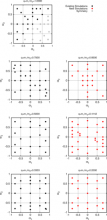
Abstract
We present the results of 74 new simulations of nonprecessing spinning black hole binaries with mass ratios q=m1/m2 in the range 1/7≤q≤1 and individual spins covering the parameter space −0.95≤α1,2≤0.95. We supplement those runs with 107 previous simulations to study the hangup effect in black hole mergers, i.e. the delay or prompt merger of spinning holes with respect to nonspinning binaries. We perform the numerical evolution for typically the last ten orbits before the merger and down to the formation of the final remnant black hole. This allows us to study the hangup effect for unequal mass binaries leading us to identify the spin variable that controls the number of orbits before merger as →Shu⋅^L, where →Shu=(1+12m2m1)→S1+(1+12m1m2)→S2. We also combine the total results of those 181 simulations to obtain improved fitting formulas for the remnant final black hole mass, spin and recoil velocity as well as for the peak luminosity and peak frequency of the gravitational strain, and find new correlations among them. This accurate new set of simulations enhances the number of available numerical relativity waveforms available for parameter estimation of gravitational wave observations.